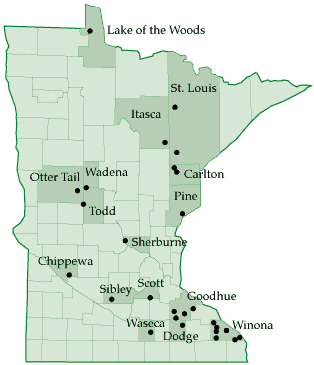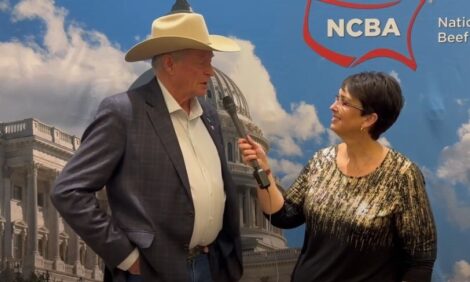



A survey of twenty-nine grazing operations in Minnesota Part 2
By Brian Loeffler, Helene Murray, Dennis G. Johnson, Earl I. Fuller.
Farm Overview
Cooperating farms were located throughout much of Minnesota. Approximately half (14) of the farms were located in the southeastern region of the state, a region with many MIG practitioners. A map illustrating approximate location of farms included in the study is provided in Figure 2.Farm Business Volume
Reported gross farm incomes ranged from approximately $16,000 to $402,000.
Gross farm income included milk sales, dairy livestock sales for livestock purposes, dairy livestock for slaughter, other livestock sales, crop sales and government payments when applicable.
 Figure 2. Locations of farms pparticipating in the study |
Farm Size
Reported total land base ranged from 78 to 895 acres. Average farm size was approximately 300 acres. Rented land accounted for an approximate average of 15% of total farm size.
A total of 1,673 cows were being milked on the 29 farms at the time of the survey. Herd size ranged from 16 to 120 cows, with an approximate average of 58 cows in each herd. The 1992 average Minnesota dairy herd size was 48 cows (Agricultural Census 1992).
| Number | Reported income level |
| 5 | less than $90,000 |
| 7 | $90,000-$115,000 |
| 9 | $131,000-$160,000 |
| 4 | $160,000+ |
| 4 | no response |
Overview of Graziers
Grazing Experience MIG experience ranged from one year to over 25 years. Eight graziers reported they had 5 or more years of experience with MIG; two graziers said they had 20 years or more. Many graziers had experience in continuously grazing pastures prior to converting to a MIG system.Identity as a Farmer and Commitment to Farming
Participants were asked to rate their identity as a farmer and their commitment to farming on a scale from one to ten. Common responses were:
| Number | Rating (10 = high, 1 = low) |
| 18 | 10 |
| 6 | 8 |
| 3 | 9 |
| 1 | 7 |
| 1 | 5 |
Almost all surveyed strongly identified themselves as committed farmers. Most recognized farming as a way of life. Many replied that they would feel uncomfortable changing occupations. A few graziers indicated that changing occupations would not trouble them.
Enterprises Besides Dairy Herd
Nineteen farmers reported having livestock enterprises in addition to the dairy herd. In most cases other livestock was used to supply food for the family or serve as companion animals (horses). Three of the 19 farmers reported having beef herds. Two respondents reported raising and selling chickens. Two graziers reported having small hog operations.
Twelve respondents reported that their spouses were employed off-farm. Six spouses were working full-time and six part-time. Employed spouses reportedly earned 2% to 100% of the income used for family living expenses. Other ventures reported were doing custom farm work and selling nursery stock.
Community Activities and Leisure Time
Farmers indicated that they were generally comfortable with their current level of participation in community activities. Fifteen graziers said that their current participation levels were adequate. Eight indicated that they would like to be more active in community activities. Six believed they were too active. Almost all graziers agreed that the lack of free time most limits their opportunity to become more involved in their community.
When questioned, over half (15) of the graziers wanted more leisure time. Twelve indicated that they were presently satisfied. Two households reported that one spouse was satisfied while the other spouse was not. Essentially all asserted that their leisure time has increased since adopting MIG.
Business Management
Marketing for Non-monetary ReasonsParticipants were asked if there are any non-monetary reasons for the types of marketing they do. Eighteen responded that there were non-monetary reasons for at least some of their marketing. Eight said no. Three had no response.
Five of the 18 who responded yes, said they supported cooperatives. This included both buying and selling transactions with cooperatives. Three direct-marketed products in an attempt to improve the consumer-producer link. They were also hoping to realize higher profits by avoiding the middleman. Two farmers reported switching milk buyers to those who didn't purchase milk from BST-treated cows. Others said that they felt comfortable with present milk buyers; were showing support for organizations like the National Farm Organization (NFO)or had no alternatives, i.e., no other buyers are in their area.
Knowledge Gathering
Graziers identified sources of information, training and experience they found valuable in managing their farm business. Common responses were:
| Number | Responses |
| 18 |
Various organizations (grazing clubs, Sustainable Farming Association)
|
| 12 |
Popular journals
|
| 12 |
University Extension and farm management courses
|
| 8 |
College or vo-tech education
|
| 8 |
Neighbors and older generation farmers
|
| 6 |
Work experience
|
| 3 |
Holistic resource management courses
|
| 2 |
Dairy Herd Improvement Association
|
| 2 |
Books
|
Networks such as grazing clubs appeared effective in sharing information among their members. Members said they typically meet once or twice a month at farms owned by club members. Participants noted that grazing club members generally rely on each other as sources of information and that they seldom seek outside experts. Many members found the clubs useful for providing management information as well as social support within the community.
Trade journals and magazines such as Hoard's Dairyman, Stockmen Grass Farmer, New Farm (now defunct), Dairy Today, Grass Farmer and Dairy Herd Management were commonly read by graziers seeking information.
Holistic Resource Management (HRM)
Nine graziers had completed courses, of whom seven said they were useful. One grazier was taking courses. Nineteen graziers had never attended an HRM class. One grazier remarked, "HRM teaches you to think for yourself. It changed my way of thinking, my goals and what is important to me." Two graziers felt the courses were not useful because they were already using many of the HRM concepts in their farming operations.
Operational Changes
Graziers were asked about changes they have made on their farms that have worked particularly well. Nineteen respondents specifically noted MIG as being successful, although this does not imply that the others didn't think it worked well. Seven reported that their renovated milking facilities have worked well. Five agreed that improved pasture management skills have been productive and two said group feeding young stock (feeding calves on milk) has worked well.
Farmers were asked which changes have been unsuccessful and what would they like to do again. Four graziers said they would like to rearrange their pasture set up. They blamed poor planning for pasture bottlenecks. Three reported having trouble with the transition to seasonal freshening and said they would do it differently if given the opportunity. Three indicated that they would not purchase some of their equipment and facilities (e.g., upright silos).
In general, farmers felt that some things haven't worked well because of a lack of short- and long-term planning. Some indicated that they would change the goals themselves. For example, many indicated that although their goals originally included purchasing the latest equipment and facilities, they now wished they had avoided those expenditures. Many of these producers have recently changed their goals and means to attain them.
Farm Transfer
Two farmers indicated that they had definite plans to transfer their farm businesses to family members. The remainder reported that they would like to provide an opportunity for family members to take over the operation some day. Some respondents indicated that if family members were not interested they would attempt to find young people who would continue the farm operation in a similar manner.
1996
TheDairySite.com News Desk


